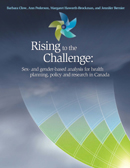|
Barbara Clow, Ann Pederson, Margaret Haworth-Brockman, and Jennifer Bernier
Rising to the Challenge is a book that describes the process of sex- and gender-based analysis and offers a collection of case studies and commentaries that illustrate SGBA in action.  The book is of interest to people working on policy, planning and research and to people at various levels of government. It will help readers understand sex- and gender-based analysis and learn how to apply it in their work for and with women and men, girls and boys. The book is of interest to people working on policy, planning and research and to people at various levels of government. It will help readers understand sex- and gender-based analysis and learn how to apply it in their work for and with women and men, girls and boys.
Sex- and gender-based analysis reminds us to ask questions about similarities and differences between and among women and men, such as:
Do women and men have the same susceptibility to lung disease from smoking? Are women at the same risk as men of contracting HIV/AIDS through heterosexual intercourse?
Are the symptoms of heart disease the same in women and men? Are x-rays equally useful for reflecting the level of disability and pain experienced by women and men living with osteoarthritis?
Do boys and girls have similar experiences of being overweight or obese? Do international tobacco control policies work the same way for men and women? By introducing such questions, sex- and gender-based analysis can help lead to positive changes in how programs are offered or how resources are allocated.
Download Full Report (8.8MB PDF)
Back to top of page
|




 Full
Report ENG (.pdf) 8.8MB
Full
Report ENG (.pdf) 8.8MB